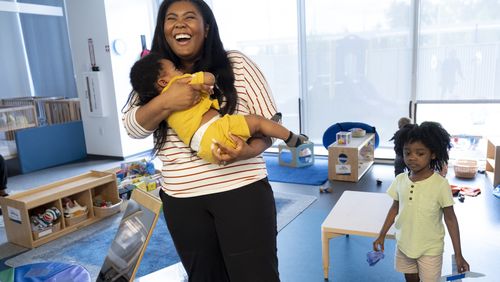The child care center called to say Rebecca Riley’s younger child was crying, they didn’t know why, they couldn’t comfort him, he wouldn’t stop.
At her previous job in an office near the airport, she would have gritted her teeth until day’s end or stopped working, grabbed her things, raced to the car and battled traffic through the city while she worried.
This time, she trotted downstairs.
“I had some teething gel,” she said. “I rubbed it in his mouth and it was okay. When there’s a problem, you’re not somewhere across town. It gives you peace of mind.”
Riley, 29, first applied for her job as a marketing specialist for Mercedes-Benz Financial Services partly because of the in-house child care provided by Bright Horizons, she said. “I hope I don’t have to leave here. It is one of those benefits that more employers should think about. I want to be a working mom.”
For Riley and millions of parents — mostly women — working and child care are intertwined.
Child care options have an effect on where women work, what kinds of jobs they take and how long they stay. And sometimes, when day care for children is costly, inconvenient or unavailable, they figure it just isn’t worth it to work at all.
The choices parents make are crucial to a family, but also to the economy.
In 2023, the share of women age 25 to 54 who were working “ticked up,” particularly among those with children under the age of 4, according to a paper released April 12 by the Atlanta Federal Reserve Bank. A Brookings Institution study speculated that flexibility and remote work were helping women.
The move by many companies to mandate a post-pandemic return to the office — sometimes three days, sometimes five — crimps choices for many women, but also deprives companies of talent, said Amy Mangan, market director for Robert Half International, a staffing agency that places workers in a range of jobs.
“We see women turn down jobs,” she said. “We’ll call them about a job that is a perfect match for their skill set and they’ll say, ‘No, I don’t even want to interview.’”
Money is often not the problem, Mangan said. “The No. 1 thing that keeps working mothers happy, that keeps them with a company, is flexibility.”
Official unemployment is low. But what’s hidden in the statistics is the way that child care roils the lives of many working people.
A recent Census Bureau survey estimated that more than 24,000 people in Georgia had lost jobs in the previous four weeks because they needed to care for children and that more than 53,000 others didn’t search for a job because of their child care responsibilities.
An additional 60,000 people were taking unpaid leave to care for children while nearly 100,000 more used vacation, sick days or other leave to attend to their children, according to the Census.
The more rigid a back-to-the-office mandate, the more pressured mothers feel, Mangan said. “Companies running badge drills or checking desks at 5 p.m. — those are places that women leave in droves. And the real issue is five or 10 years down the road when they haven’t developed any female talent.”
In contrast, some companies see child care as a way to avoid turnover.
Home Depot has a child-care center at its Store Support Center on Paces Ferry Road. The Vinings-based home repair giant subsidizes tuition, a spokesman said.
Sandy Springs-based UPS, which recently reverted to a five-day-a-week office policy, has had a pilot program in a California facility that serves as “a back-up option” when a parent’s primary dayday care falls through, as an alternative to a parent using sick days, a spokesperson said. The company plans to extend the program this year to a number of other sites, he said.
Aylo Health, which has 13 locations around metro Atlanta offering primary health care, gives employees $1,000 a month for child care for each child, said David King, chief human resource officer for the company.
“Our workforce is about 90% female and child care and rearing kids disproportionately falls on women — that’s just the way it is,” he said. “So, we rolled that out three years ago. We consider it a success.”
The state has 4,381 licensed child-care providers, about the same as before the pandemic, according to the Georgia Department of Early Care and Learning.
In that time, the number of people working is up about 6%, according to the Bureau of Labor Statistics.
For parents, cost is often a challenge, if only because the more expensive child care is, the less incentive for a parent to work. But it’s hard to make child care cheap, since it is labor intensive. In Fulton County, the median tuition for center-based child care is $9,923 a year per child, more than 25% of a woman’s median pay, according to the BLS.
At Mercedes-Benz, the company subsidizes nearly 40% of child-care cost, and it’s still about $1,200 a month per child, said Jianan Sun, a manager of digital products whose two young children are downstairs in day care five days a week. “A lot of people I know, as soon as they have a second child, that’s when they quit their jobs.”
Even so, the median pay for child-care workers, including many with degrees and specialized training, is $14.60 an hour, which leads to rapid turnover, the BLS said.
One of the nation’s largest child-care providers, Bright Horizons, which provides child care at Mercedes-Benz, has seen a spike in demand, partly because of return-to-office mandates, said Stephen Kramer the company’s CEO.
Bright Horizons has standalone sites, but also many at corporate offices, he said.
“Child care is having a renaissance,” Kramer said. “There is more demand than there is supply. We are seeing that working parents are speaking up and looking to their employers to fill the void so that they can remain in the workforce.”
Yet many do not.
The nation’s workforce includes 77.4% of the women between the ages of 25 and 54, compared to 89.2% of the men in that age range, according to the BLS. That difference represents millions of potential workers.
Giana Hughes, 32, a single mother who lives in Stone Mountain and who has a daughter in kindergarten, quit her job several years ago when a family member was no longer able to take care of her child.
“Child care is one of the biggest factors in deciding whether I can take a job, whether it’s feasible, whether it’s affordable, whether it’s good quality,” she said. “It can be impossible to find a full-time job when you have to pick up your child at 2:45.”
She now works freelance as a marketing and branding adviser, more of a side-hustle than a full-time gig, but one with lots of flexibility. Disentangling decisions about work from child care is near impossible, Hughes said. “You can’t have child care if you don’t have a job and you can’t get a job if you don’t have child care.”
Child care snapshot
Metro Atlanta average cost, child care center: $9,923 a year
Metro Atlanta average, infant care: $11,203 a year
U.S. average cost, child-care center: $11,960
Metro Atlanta pay for open child-care positions: $13.50 to $22 per hour
U.S. average pay for child-care worker: $14.60 per hour
U.S. total child-care workers: 1.06 million
U.S. average cost, nanny care: $766 a week ($39,800 a year)
Workforce snapshot
Women: 79.1 million
Men: 88.8 million
Participation, women: 57.6%
Participation, men: 68.0%
Participation, working age women: 77.4%
Participation, working age men: 89.2%
Sources: Georgia Department of Care and Early Learning, Bureau of Labor Statistics, Department of Labor Women’s Bureau, Care.com, Indeed







